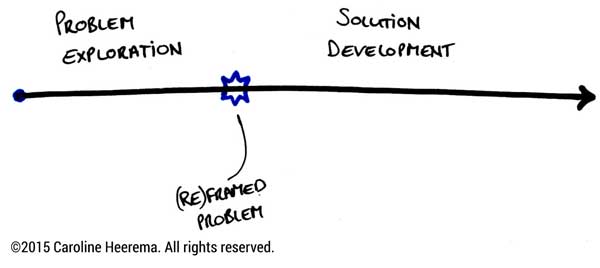January 13, 2015 — Arlington, Massachusetts

Figure 1 — The design thinking process can be divided
into activities for problem exploration and activities
for solution development.
Author Caroline Heerema had in-depth conversations on the design thinking process with interviewees from two companies. In these interviews, she uncovered two core mechanisms that are key to achieving an effective process with a successful outcome -- the first is the separation of activities that explore the problem from solution development tasks.
She found that "... it is key to have a clear separation between activities that serve to explore and define the problem and activities that are part of the development of solutions for that problem. It is important for the teams to have a clear consensus about where they are in the process and to avoid mixing these two activity types. We can conceive of problem exploration and solution development as the two main parts of which a design thinking process consists (see Figure 1)."
In beginnning of a design thinking process, Heerema notes, "The team first puts extensive effort into understanding the problem, taking into account all its possible facets, the different users, and context. The aim of this part of the process is to arrive at a holistic understanding of the issue at hand, which can be channeled into a clear definition of the problem. While it may seem like a paradox, it is only when the full complexity of a situation is taken into account that it can be (re)framed in a concise and meaningful way. During this part of the process, it is highly counterproductive to already think in terms of possible solutions. After all, you cannot develop a really relevant solution if you do not yet understand the real core of the problem it should solve. By mixing in elements of solution development, teams risk narrowing their view too early and committing to a direction that causes them to miss out on meaningful and valuable opportunities."
It is only after the problem is defined that activities for developing a solution can be begin. "These typically include various rounds of ideation, prototyping, and testing of solutions. These activities take outset in the problem definition and keep this definition and the understanding that has been developed as a frame of reference. That way, a team can stay on track and on the same wavelength while venturing into the development of a myriad of ideas, new concepts, and concept elements. Amidst these activities, it would be counterproductive if the team, or single members of a team, started questioning the framing of the problem or were to bring in ideas for solutions that address a different problem than the one defined. This punctures the team's momentum and gets it out of sync."
Heerema cautions that switching between these activities "must always be a conscious decision and not something that the team or individual team members do arbitrarily. This applies both for advancing from finished exploration to starting solution development and for circling back to exploration."
* Excerpted from "Creativity in a Formula? A Peek Behind the Curtains of Design Thinking in Business," (![]() ) Business Technology & Digital Transformation Strategies Executive Report Vol. 18, No. 9
) Business Technology & Digital Transformation Strategies Executive Report Vol. 18, No. 9

